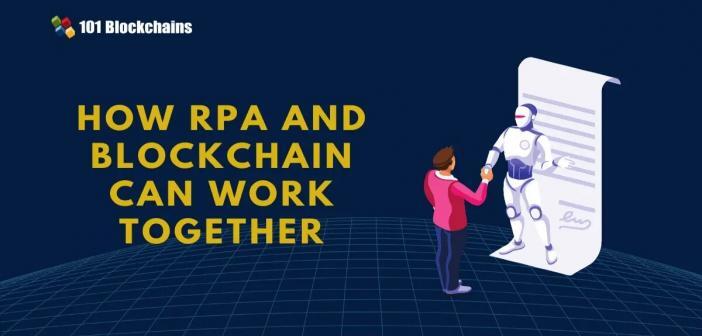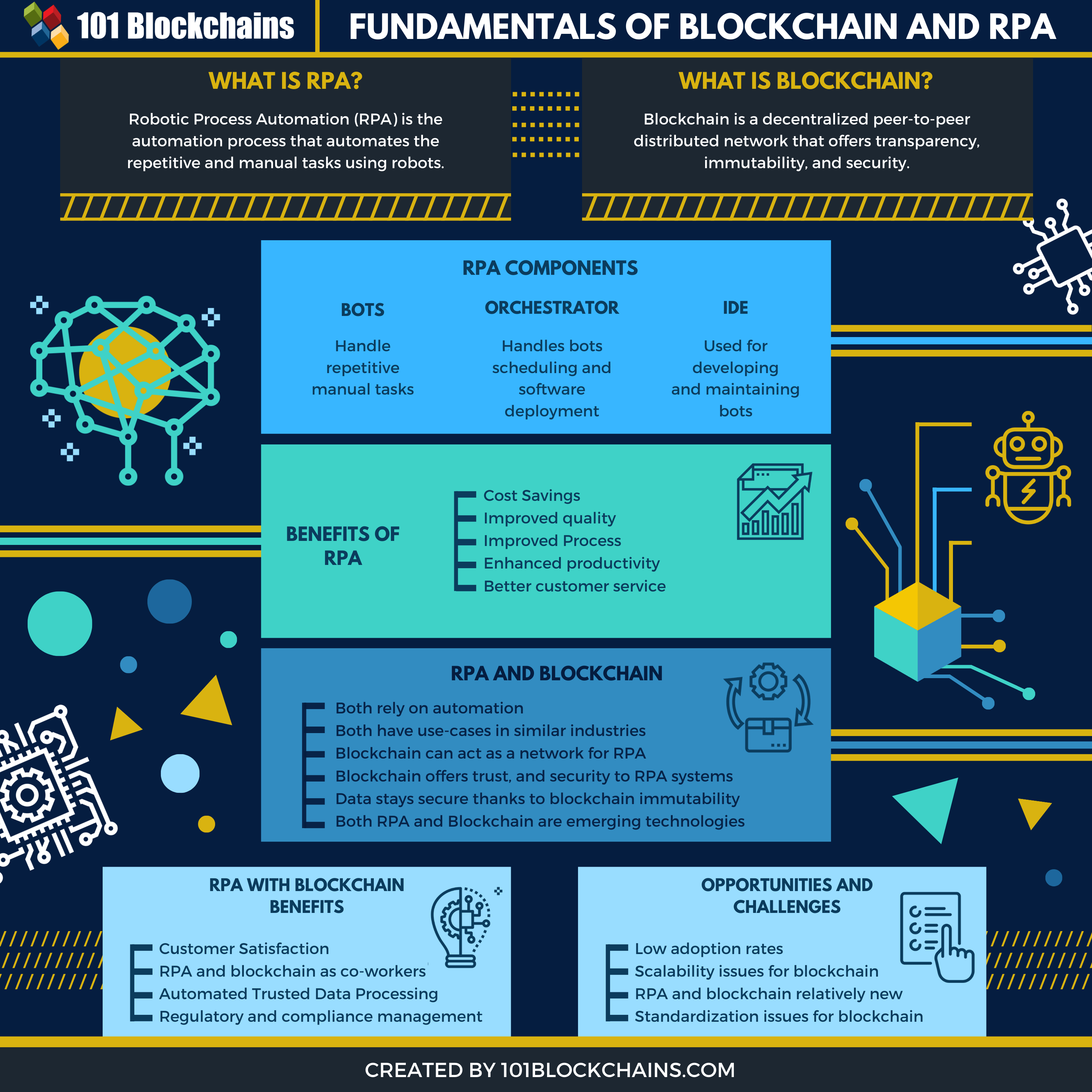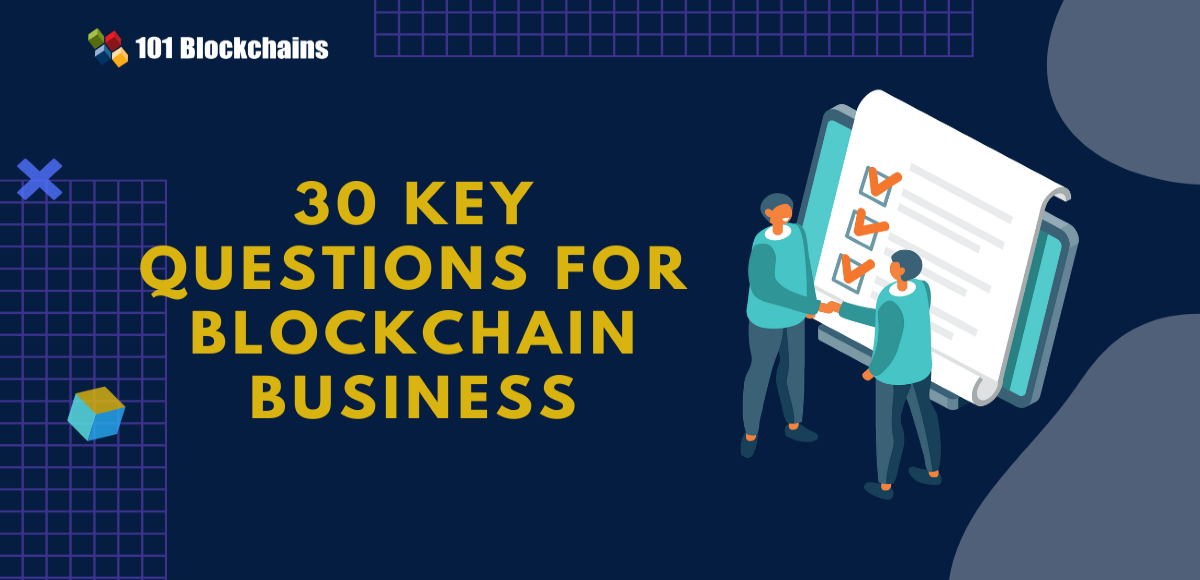Learn how blockchain truly works, master key definitions, and uncover what makes smart contracts so "smart." Dive into the fundamentals, gain valuable insights, and start your blockchain journey today!

- Opinions
101 Blockchains
- on February 09, 2021
How RPA And Blockchain Can Work Together
This article offers detailed information on RPA and the correlating points between RPA and blockchain. Also, you’ll understand the challenges and opportunities of combining blockchain and RPA together.
RPA is one of the latest technologies that is disrupting the industry out there. Few of the other technologies that are also making the news include blockchain, artificial intelligence. Our society is an ecosystem, and hence all these technologies are related to each other.
In this article, we are going to discuss RPA and Blockchain. Each of these technologies is disruptive. Companies, on the other hand, are quick to adopt the new technologies so that they can leverage the advantage and penetrate deep into the market.
They are also more likely to combine technologies to get the best possible result for their organization. For instance, they will most likely be combining RPA and blockchain. We will discuss the effects of the integration of RPA with blockchain. However, the article is not about blockchain vs RPA.
Build your identity as a certified blockchain expert with 101 Blockchains’ Blockchain Certifications designed to provide enhanced career prospects.
What is RPA or Robotic Process Automation?
Robotic Process Automation (RPA) is the automation process that automates repetitive and manual tasks using robots. It is done with the help of the software bot.
RPA’s popularity is because of how useful it is in the current industrial practices. It can interact with any modern system, just like a human would do. This makes automating a wide range of tasks easy for industries. It is hailed as a revolution in business process automation. After all, it is one of the emerging technologies out there.
In technical terms, RPA can be defined as the technology that works around structured inputs and business logic. RPA results in business process automation. In RPA, a robot or software is configured to interpret and capture the data related to an application and then use that data to handle all the different tasks related to it, including data manipulation, responses, and communication.
There are many benefits of RPA. Let’s list them below.
- Improved Process
- Cost Savings
- Improved productivity
- Higher quality
- Improved customer service
Other benefits include better Audit trial, reliability, retention, consistency, saving potentials, cross-industry, scalability, and so on.
Components of RPA
Let’s take a look at the basic components of RPA. They are as below.
- Bots: At the core, there is a bot that is coded to perform the desired result. They have macros to have the best efficiency.
- Orchestrator: Orchestrator ensure that the software is deployed and schedule bots
- IDE: IDE stands for an integrated development environment that developers can use to develop and maintain bots.
Please include attribution to 101blockchains.com with this graphic. <a href='https://101blockchains.com/blockchain-infographics/'> <img src='https://101blockchains.com/wp-content/uploads/2020/02/Blockchain_and_RPA.png' alt='RPA and Blockchain='0' /> </a>
What is Blockchain?
Now that we have a basic understanding of Robotic Process Automation (RPA), it is now time for us to explore blockchain.
Blockchain is a peer-to-peer network capable of functioning without the need for a centralized entity. The decentralized approach brings a lot of features on the board, including transparency, immutability, security, and so on. With the Ethereum blockchain, automation is also a possibility, thanks to the inclusion of smart contracts.
Learn the fundamentals of Blockchain through Blockchain Basics Flashcards
RPA and Blockchain Applications
People often wonder — where does RPA fit in with other emerging technologies?
RPA and blockchain are emerging technologies and have the potential to change how industries work. Both technologies can impact almost every sector out there. We can see use-cases of RPA and Blockchain in industries such as retail, insurance, finance, government, healthcare, and so on.
Automation is a big thing right now. Companies are reliant on automating things so that they can use their free time to solve creative problems. One of the biggest currencies of the current generation is creativity and problem-solving. This means that they can use automation to solve trivial requirements, whereas they can use humans to take more crucial tasks that require understanding, learning, creativity, and approach. The infrastructure created can handle itself by using RPA and blockchain.
For instance, process automation is a critical part of any industry. RPA can handle the process automation and hence save costs required to cost high volume and repetitive tasks that require rules to work.
The automotive industry, for example, can benefit immensely from RPA. A normal office with repetitive tasks in the front office can also be automated using RPA.
Blockchain, on the other hand, also has its fair share of use-cases. It’s the biggest impact can be seen in the trade finance sector and supply chain management. Other sectors are also bringing changes to their processes and solving pain points that were ignored until now. For instance, it is changing the banking system and providing faster settlements and easier account management.
What Happens When RPA And Blockchain Work Together?
It is quite often for industries to combine multiple technologies to get the best possible outcomes. The market is very competitive, and customers are expecting more from brands than ever before. That’s why companies need to evolve beyond their strategy.
With technologies working together more seamlessly than ever, it is now easy for businesses to adopt them and create a system that works best for them as well as the end-user. Also, the data collected by companies are massive enough for them to try out new combinations. All of these are possible with the combination of RPA and blockchain.
RPA is all about playing a central role in automating the different aspects of the business. You can think of RPA as a consensus entity that can interact with both systems and end-users. It is made in such a way that it can interact and react with real-time data and make sense of it. Here, the workforce is all designated to find out the processes that can be automated. They should also take care of training co-workers.
So, where does blockchain fits in all of these?
Blockchain can provide a distributed, shared ledger to process all the data and information. It provides a smart, trustworthy, and smooth exchange platform for all the involved parties.
Start your blockchain journey Now with the Enterprise Blockchains Fundamentals
Benefits of Using RPA with Blockchain
RPA can enable blockchain when it comes to information exchange among different IT infrastructures. RPA and blockchain can also work well when it comes to monitoring and doing transactions across the system. With the trust of blockchain, RPA can work seamlessly and provide information within the environment without any worries.
The transactions can be validated and then transmitted with the help of the blockchain. Also, all the data can be stored in the decentralized ledger, providing immutability to the stored data.
For companies, this means that audit trials will be elementary to conduct. They can automate the workflow and ensure maximum productivity to meet customer’s demands.
There are many benefits of RPA and blockchain —
-
Regulatory and Compliance Management
Compliance is a big concern for businesses out there. They need to ensure that their process is compliant with the regulatory guidelines assigned by the governance that they are currently operating. Things get more complicated if they operate globally. RPA and blockchain can work together to automate repetitive compliance tasks.
In creating regulatory and compliance management, blockchain plays a key role by offering immutability to the recorded events. All the events can also be accessed through the network, enabling external audits as well. This can be applied to currently available regulatory such as GDPR.
-
Automated Trusted Data Processing
Another obvious use-case of Blockchain and RPA is to create automated trusted data processing. This has wide-range use-cases where blockchain acts as a core network to manage the data transmitted by another process.
The decentralized ledger does wonder here as it offers a way to record processes data and business transactions for the automated decisions made by RPA. The best use-case for automated trusted data processing is the KYC process, insurance claim payments, HR recruitments, and so on!
-
Customer Satisfaction
RPA and blockchain can also work together to create better customer satisfaction with fast, automated transactions that are secure and reliable.
-
RPA And Blockchain Co-Worker
Both RPA and blockchain can create a more sustainable co-worker for human companions.
Curious to learn about blockchain implementation and strategy for managing your blockchain projects? Enroll Now in Blockchain Technology – Implementation And Strategy Course!
Opportunities and Challenges of RPA and Blockchain
RPA and blockchain are both new technologies that are seeing rapid growth on their own. The rapid growth brings its own set of challenges. If you take blockchain as an individual technology, it suffers from problems like standardization, scalability, and interoperability.
The main issue here is decentralization! It is hard to standardize. Scalability is an issue as well. However, new generation blockchain solutions are more scalable, but they are no way closer to the scalability offered by more traditional solutions, including VISA. Right now, blockchain is actively improved to solve these core problems.
Hyperledger, for instance, is working towards a unified framework that can be utilized by different organizations. This will improve both adoption rates and standardization.
Even though RPA doesn’t have that many challenges, it still suffers from adoption rates. Companies are not properly utilizing RPA to automate their business functions. Most of them are simply using RPA to automate human labor. However, they should strategically think about how to make the most out of the RPA. In simple words, they should improve their value proposition when they adopt RPA into their business process.
Organizations should also be careful when it comes to adopting RPA with blockchain technology. Also, organizations should always do a pilot position to estimate the impact of RPA and blockchain implementation.
As a business, you should ensure that you identify key success metrics, align to business goals, and understand the requirements.
Conclusion
This leads us to the end of our RPA and blockchain analysis. Do you think that RPA with blockchain is a good choice for your organization? If you do, comment below and let us know.
If you want to about more fundamental concepts related to blockchain just like this one, make sure to enroll in our blockchain courses!





![Future of Blockchain: Predictions for 2022 [UPDATED] future of blockchain predictions](https://101blockchains.com/wp-content/uploads/2020/12/future-of-blockchain-predictions.png)

